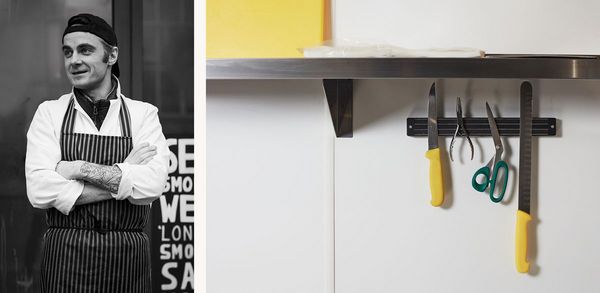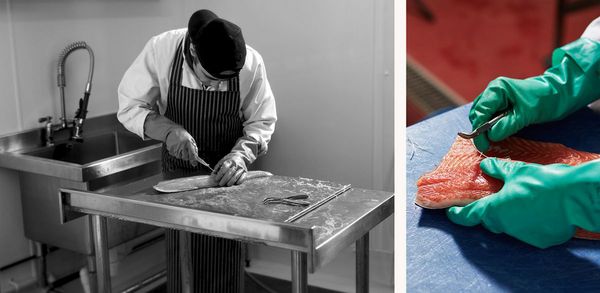
Find a cure: meet the man behind London’s best smoked salmon
From an unremarkable railway arch in Hackney, Max Bergius is reviving London’s great smokehouse traditions
Words Henry Jeffreys
Photography Ronan Gallagher

Scottish smoked salmon is a London invention. The technique of preserving the fish with salt and smoke was brought over by Jewish immigrants from Eastern Europe in the nineteenth century, Today, in acknowledgment of this unique heritage, London cure Scottish smoked salmon is a protected European food like Stilton cheese, Parma ham or Jamón Ibérico.
In order to qualify for a PGI (protected geographical indication), the produce has to be Scottish farmed or caught salmon, and cured using only salt and oak smoke within the London boroughs of Hackney, Tower Hamlets or Newham. These once down-at-heel but now upwardly mobile areas of the city used to be densely populated with smokehouses large and small, but as time went by they all but disappeared.
Now the smokehouse tradition is being revived by small-scale producers like Max Bergius whose professional background is in art and publishing rather than fish. His Secret Smokehouse has only been open since 2016 but Michelin-starred chef Claude Bosi from London’s Chelsea eatery Bibendum has already pronounced its smoked salmon as ‘the best I’ve ever tasted’.


‘ Serve it with a glass of good white Burgundy, the best you can afford ’

Gaggenau: How did you get into smoking fish?
Max Bergius: Growing up on the west coast of Scotland I would fish and smoke my own catch. When I ‘tapped out’ of my magazine business, I took a fish-filleting course at Billingsgate market in London and then worked in a fishmongers. I started smoking from my tiny garden in Stepney using a shed I bought for £200 plus another £100 on equipment. The locals caught wind of it and loved it. It reminded them of how smoked fish used to taste.
Gaggenau: What’s so special about the East End of London?
MB: This area has a great tradition of smoking fish. At one point there were something like 60 smokehouses in the E1 postcode alone. I moved to a railway arch in Hackney in 2016 so that my fish would qualify for PGI status. Nowadays there’s a real vibe about the area – I’m at the centre of the London food scene. Within six miles we have 90 per cent of the UK’s top restaurants.
Gaggenau: What makes your smoked fish different?
MB: I do everything by hand. I fillet the fish, cure it with salt, then it’s washed, slowly cold-smoked for a day, dried and sliced. There’s nothing complicated, no alcohol, no sugar, just salt and oak smoke. The secret is in getting the details exactly right. Cheap smoked salmon is greasy because producers freeze their fish to make it easier to slice with a machine which makes the oil leak out. Why ruin a beautiful product? You should taste the salmon rather than the smoke.


Gaggenau: Who are your customers?
MB: People on the hunt for something special. I supply some of Britain’s top restaurants such as The Marksman, Wiltons and Nathan Outlaw, plus shops like La Fromagerie and Fortnum & Mason.
Gaggenau: What sort of fish do you use?
MB: My raw materials are haddock, herring, trout and salmon that are incredibly fresh. I work with small, high-quality salmon farms in Scotland and sustainable fishermen. When I started I’d turn stuff down or send it back; it has to be the very best.
Gaggenau: How should you serve your fish?
MB: My smoked salmon doesn’t need lemon, pepper or bread and butter. I recommend serving it just with a glass of good white Burgundy, the best you can afford. With such lovely fish you might as well bring out the big dogs!
